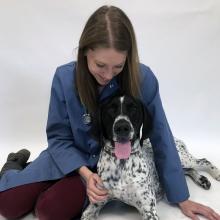Hey team, hope everyone is having a great summer so far!
After two weeks at Picton Animal Hospital, I can honestly say that I’ve received amazing mentorship, and I’m so happy that I chose this clinic for my externship. All of the staff have been exceptionally friendly and patient, and the receptionists, groomers, technicians, and veterinarians have all taken the time to answer my questions, show me what they’re doing, and have me assist and even perform procedures for them.
 A bonus that I wasn’t expecting was that two new 2018 grads from OVC started their careers at PAH at the same time as I started my externship. While I was worried at first that this would mean I would have less opportunities to learn and participate, I couldn’t have been more wrong! On top of learning about medicine and everyday clinic life, I have also received fantastic mentorship about my final year of vet school as well as what to expect during the transition into my first job as a veterinarian. I have been able to watch the progression of their roles and responsibilities, and learn what resources are available to me next year if I see a case presentation I am not familiar with.
A bonus that I wasn’t expecting was that two new 2018 grads from OVC started their careers at PAH at the same time as I started my externship. While I was worried at first that this would mean I would have less opportunities to learn and participate, I couldn’t have been more wrong! On top of learning about medicine and everyday clinic life, I have also received fantastic mentorship about my final year of vet school as well as what to expect during the transition into my first job as a veterinarian. I have been able to watch the progression of their roles and responsibilities, and learn what resources are available to me next year if I see a case presentation I am not familiar with.(Photo on the left, Macauley Mountain Conservation Area has beautiful walking trails, and is just 5 minutes from my apartment.)
4DX Testing
It’s heartworm season now here in Ontario, which means the staff at PAH are busy running 4DX snap tests on many of our canine patients. This blood test looks for four diseases commonly obtained during the summer from mosquitoes and ticks: heartworm disease, Lyme disease, Ehrlichiosis, and Anaplasmosis. The last two diseases are rarely seen here in Canada, but dogs who have been to the Southern United States will sometimes turn up positive. We like to run 4DX tests to make sure that dogs are free of heartworm disease before we put them on preventive medications for the summer, because some of these medications are not safe in heartworm positive dogs. It is also just generally a good idea to test for these diseases every few years because they can be dangerous to our dogs’ health!
Anaplasmosis. The last two diseases are rarely seen here in Canada, but dogs who have been to the Southern United States will sometimes turn up positive. We like to run 4DX tests to make sure that dogs are free of heartworm disease before we put them on preventive medications for the summer, because some of these medications are not safe in heartworm positive dogs. It is also just generally a good idea to test for these diseases every few years because they can be dangerous to our dogs’ health!
It’s heartworm season now here in Ontario, which means the staff at PAH are busy running 4DX snap tests on many of our canine patients. This blood test looks for four diseases commonly obtained during the summer from mosquitoes and ticks: heartworm disease, Lyme disease, Ehrlichiosis, and
 Anaplasmosis. The last two diseases are rarely seen here in Canada, but dogs who have been to the Southern United States will sometimes turn up positive. We like to run 4DX tests to make sure that dogs are free of heartworm disease before we put them on preventive medications for the summer, because some of these medications are not safe in heartworm positive dogs. It is also just generally a good idea to test for these diseases every few years because they can be dangerous to our dogs’ health!
Anaplasmosis. The last two diseases are rarely seen here in Canada, but dogs who have been to the Southern United States will sometimes turn up positive. We like to run 4DX tests to make sure that dogs are free of heartworm disease before we put them on preventive medications for the summer, because some of these medications are not safe in heartworm positive dogs. It is also just generally a good idea to test for these diseases every few years because they can be dangerous to our dogs’ health!
(Photo on the right shows the saphenous vein which is on the hind leg and is one of the sites we use for blood collection in dogs and cats - it’s on the inside of the leg in cats!)
Since PAH is doing a lot of 4DX testing right now, I got a lot of practice drawing blood samples from our canine patients this week. I didn’t have a lot of experience taking blood before coming to PAH, so I started out on our calmer, bigger dogs (bigger dogs have bigger veins!), and am working my way down to smaller, more wiggly patients. My next challenge will be to practice taking blood from our feline patients, who have much smaller veins, and are often a bit more anxious at the clinic. I also want to get more practice placing IV catheters in the coming weeks.
Ears, Rears, and Feet
Something else I saw a lot of this week was allergies. Allergies are very common in dogs, and many breeds, such as Terriers, Retrievers, and Shih tzus are genetically predisposed to developing them. Like in people, allergies can be very frustrating to manage. I say “manage”, because this is not a condition we can cure. We usually cannot get rid of all the symptoms of allergies, but we can reduce their severity, and certainly make our itchy friends more comfortable.
Something else I saw a lot of this week was allergies. Allergies are very common in dogs, and many breeds, such as Terriers, Retrievers, and Shih tzus are genetically predisposed to developing them. Like in people, allergies can be very frustrating to manage. I say “manage”, because this is not a condition we can cure. We usually cannot get rid of all the symptoms of allergies, but we can reduce their severity, and certainly make our itchy friends more comfortable.
Like us, some dogs have seasonal allergies, and others have food allergies. Some of the common manifestations of food allergies, as I’ve learned this week, are “ears, rears, and feet”. If we see a dog who is coming in for chronic ear infections, GI upset, anal gland troubles (butt scooting on the carpet!), or constantly licking and chewing at their feet (the classic white dog with red feet) we start to suspect a food allergy.
Food allergies typically involve one of the animal proteins in our pets’ diet (including treats and table scraps), such as chicken, beef, or eggs. If your dog has a food allergy, we can try a “novel” (new) protein source, a “hydrolyzed” diet (the protein is broken down enough that most animals won’t react to it), or a vegetarian diet (these are safe to use in dogs, but NOT in cats!!!). For dogs with seasonal allergies, we have several “anti-itch” type medications, but like in people, the best we can usually do is control symptoms, not prevent the reaction. Some clinics do however offer allergy shots for dogs!
.JPG) That’s all for today, thanks for reading! Before I let you go, I have a little quiz: what are we looking at here? And for those of you studying at OVC right now, how do you treat it?
That’s all for today, thanks for reading! Before I let you go, I have a little quiz: what are we looking at here? And for those of you studying at OVC right now, how do you treat it? Hint: it’s a little friend I found on the underside of a cat’s tail!
